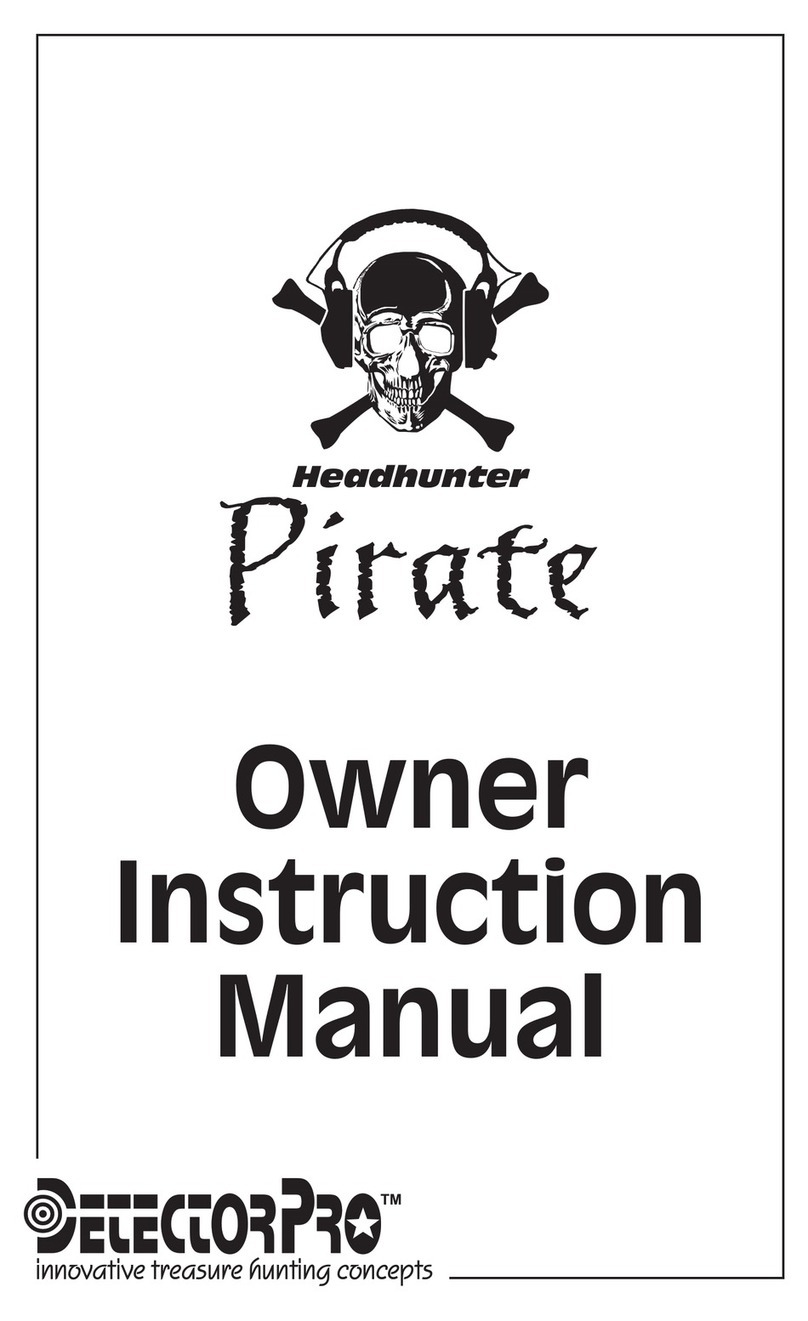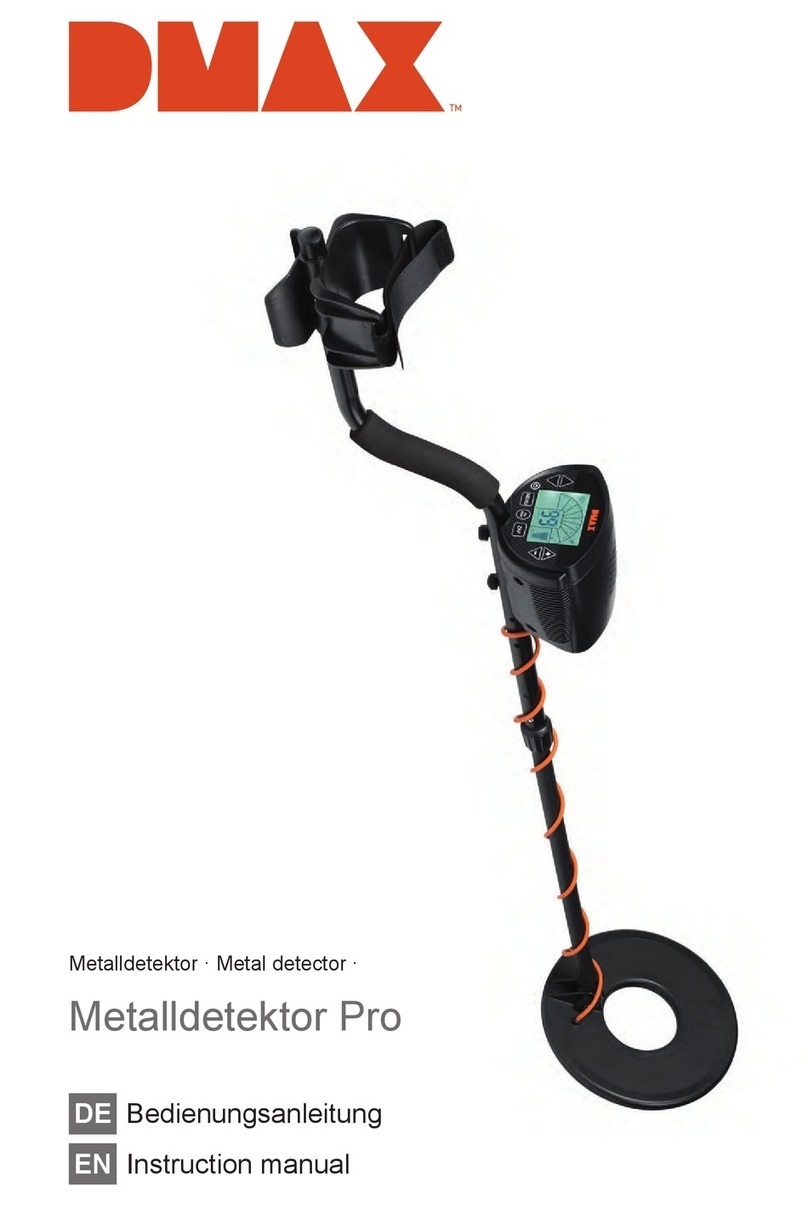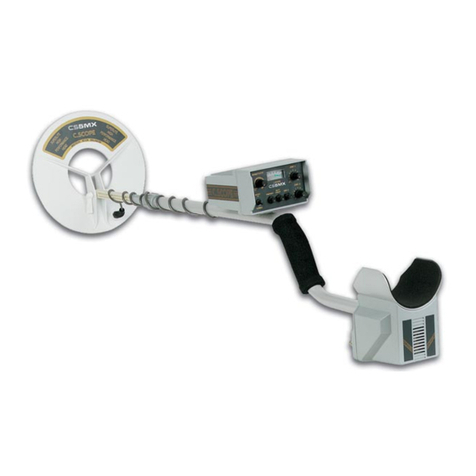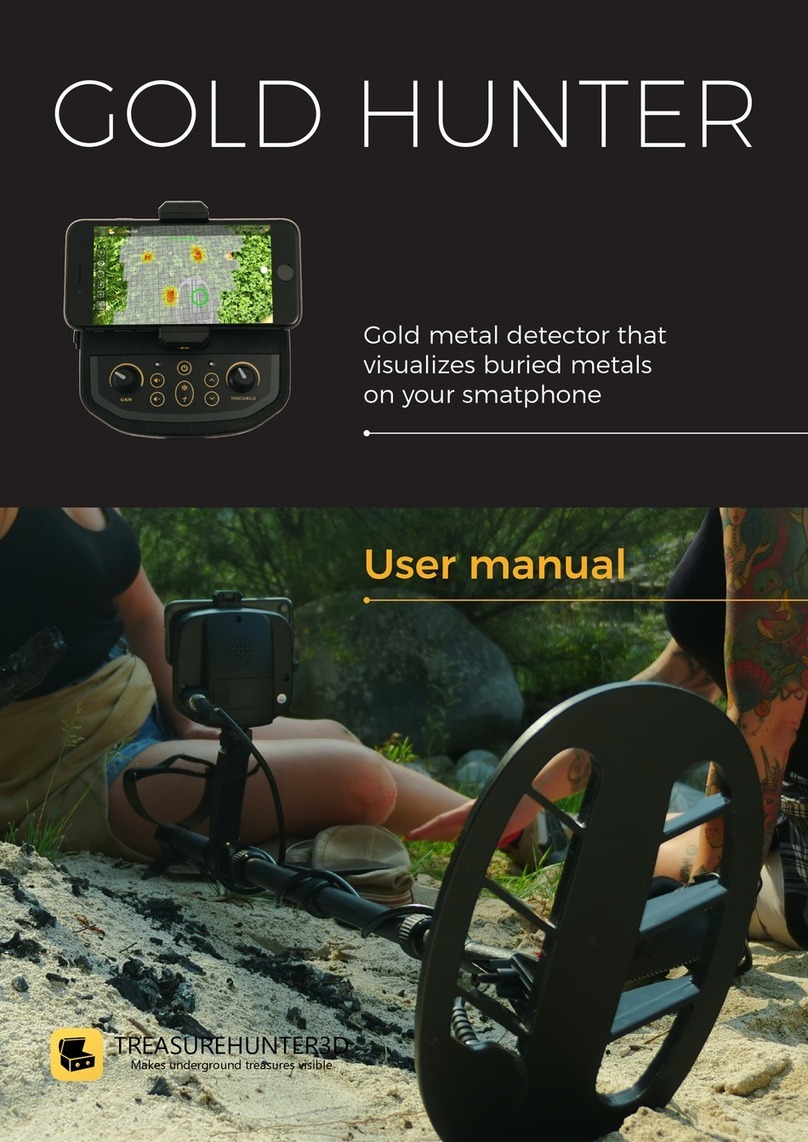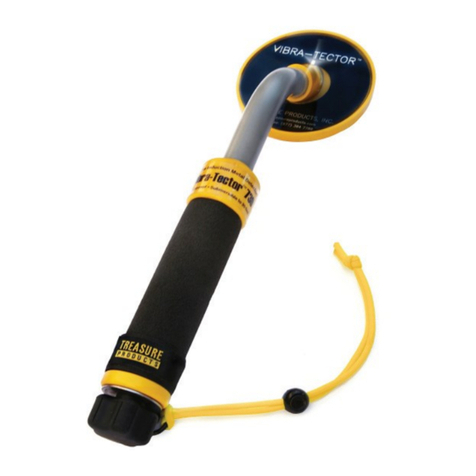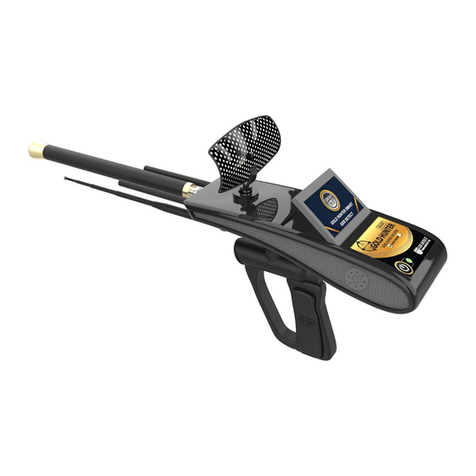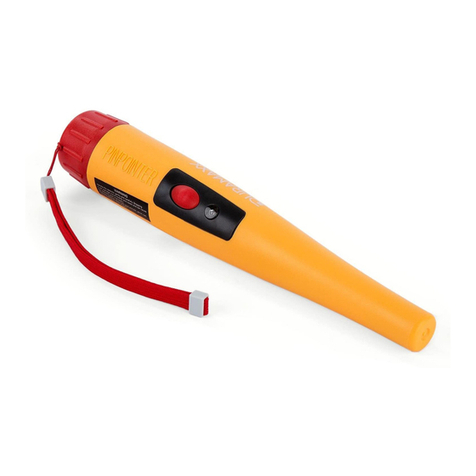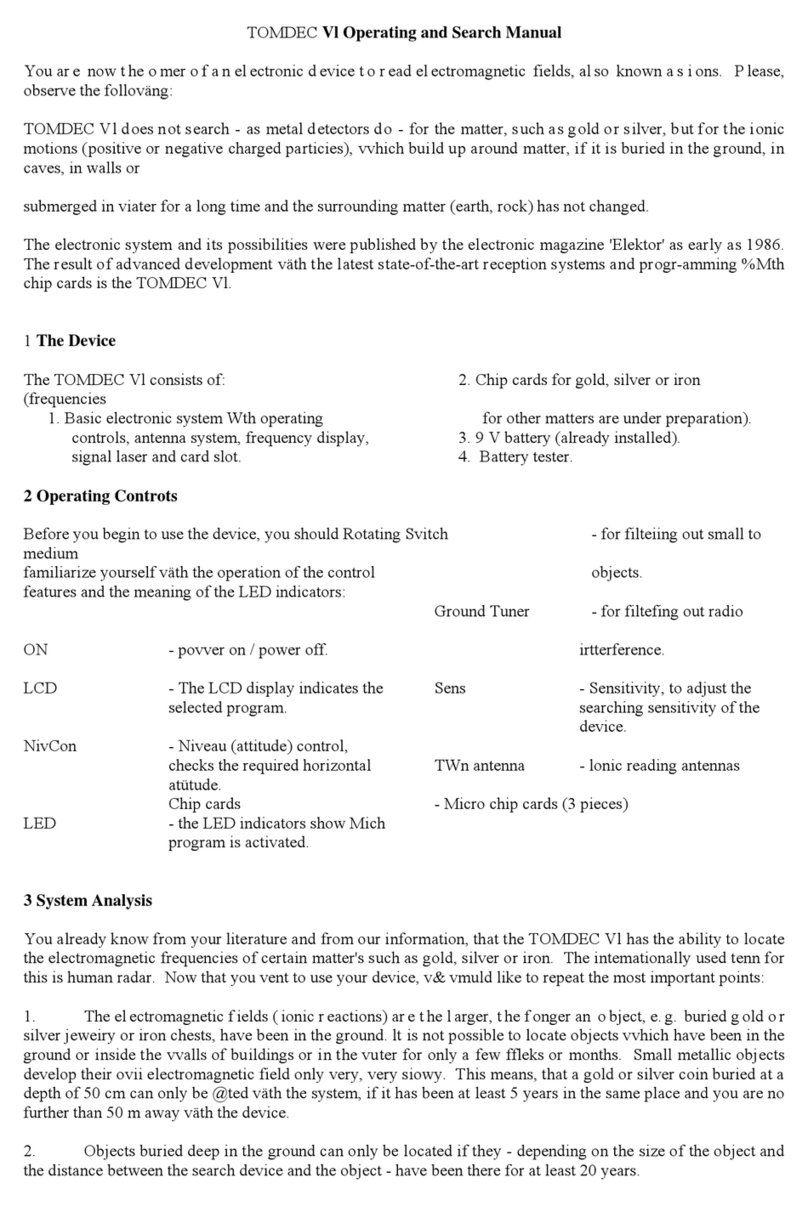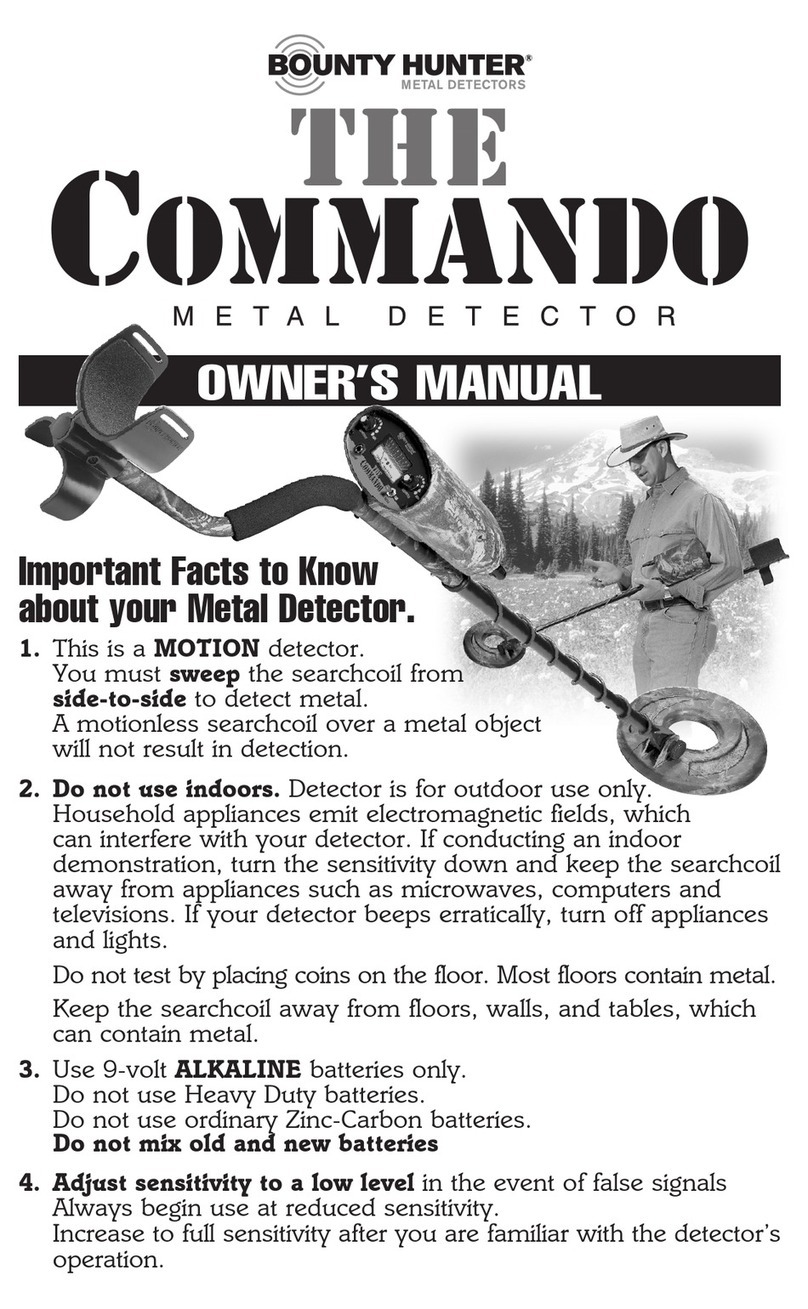DetectorPro Headhunter Pulse Setup guide

Owner
Instruction
Manual
TM
innovative treasure hunting concepts
TM
HEADHUNTER
P U L S E

INTRODUCTION
2
Thank you for buying our HEADHUNTER metal
detector. You have purchased one of the most compact
underwater metal detectors in the world. Not only does
this metal detector contain today's most innovative
electronics, it is the first water detector that has all the
electronics built into the headphones. By eliminating a
control housing, weight of the detector is significantly
reduced and so is your arm fatigue. When you travel, the
HEADHUNTER also takes up very little room. All of this is
possible because of our innovative micro circuitry and
packaging design. The HEADHUNTER was engineered to
perform best in salt water.
HEADHUNTER opens up a whole new world of
excitement. Thousands of valuables are continuously lost
each year and you can now start finding them. Learn the
operation of your new metal detector well, do site
research, obey the law, and respect the rights of others. If
you do all of the above, you will have an enjoyable,
successful hobby that will give you pleasure and relaxation
for years to come.
Happy hunting and good luck,
Gary Storm
President - DetectorPro
TM
HEADHUNTER
P U L S E

ASSEMBLY — WADING
3
TM
innovative treasure hunting concepts
Searchcoil
Nylon Thumbnut & Stud Assemblies (3)
Nylon Wingnuts &
Stud Assembly
Searchcoil Cable
w/ Protective Cover
Headphones
w/ Circuitry
& Controls
(batteries
not included)
Middle Shaft
Spring Buttons (shaft assembly & adjustment)
®
Velcro Cable Anchor
Isolator &
®
Velcro Cable Anchor
Lower Shaft
Arm Cup Halves
(adjustable)
Upper Shaft
w/ Foam Handgrip
NOTE: All parts are utilized in the
WADING configuration.
TUNE
FREQ
OFF
VOL
Waterproof
Connector for
interchangeable
searchcoils

TERMINOLOGY
4
If you are new to metal detecting, we have provided
definitions below to help you better understand
terminology used in this manual. The following was
reprinted with permission from: DETECTORIST, A How-To
Guide to Better Metal Detecting, by Robert H. Sickler.
AIR TEST - A test to determine the maximum sensitivity a
metal detector is capable of under ideal conditions. Various
sized metal samples are held beyond the searchcoil
bottom at varying distances to determine the limits of
audio or visual response. Air tests are not accurate
indicators of ground penetration ability. (see BENCH TEST)
ALKALINE - A grade of battery composition which sustains
higher current drain and possesses a greater shelf life than
basic carbon-zinc types.
BENCH TEST - Another form of air test used to define
which discriminate settings accept or reject various target
samples. Detector is placed upon a stationary, nonmetallic
rest and samples are manually passed across the bottom of
the searchcoil.
CARBON-ZINC - The standard or basic grade of drycell
battery.
DISCRIMINATION - Circuitry and the mode of operation in
which audio or visual responses from undesired metal
objects are intentionally eliminated.
PINPOINTING - The act of aligning the center of target
response width to the designated searchcoil center for
accurate location and careful recovery.
PULSE INDUCTION - Otherwise referred to as PI. This type
of detector ignores both nonconductive and conductive
minerals simultaneously by pulsing the receiver amplifier
off before the response from wetted salts and iron oxides
can reach the searchcoil winding. PI detectors are capable
of extreme depth on both ferrous and non ferrous targets.
SENSITIVITY - The measure of a metal detector's capacity
to sense changes in conductivity throughout the pattern
of detection set forth by the searchcoil configuration. (see
AIR TEST)
TARGET - Any buried or hidden object which a metal
detector responds to.
VOLUME CONTROL - A metal detector control which
regulates the loudness of target response.

CONTROLS
5
HEADHUNTER PULSE models have three controls for the
operation of the special designed, highly sensitive, Pulse
Induction circuitry. This circuitry is located in one of the
sealed earcups of the headphones. Batteries are located in
the other earcup, and are user accessible.
On/Off - Volume Control (VOL): This control turns the
power on and off and controls the level of audio the
detector reports to the user. This adjustment is set to user
preferences.
Tuner Control (TUNE): Sets the Threshold background
audio level.
Frequency Control (FREQ): Sets the sensitivity and
response the unit will have to detected metals with
variable amplitude audio (pitch).
The control earcup should be worn on the side of the head
opposite the arm used to sweep the search coil rod. This
will allow the free hand to comfortably make adjustments
as needed.
TM
innovative treasure hunting concepts
TUNE
FREQ
OFF
VOL

OPERATION
6
Operation Instructions:
The HEADHUNTER PULSE metal detector is a very easy
detector to use. It's a turn on and go detector. It employs a
fully automated circuit retuning so that the threshold level
remains steady in all ground conditions. The search coil
must be in motion to maintain an audible target signal. The
following is the basic startup procedure.
1) Set TUNE control approximately to the halfway position.
2) Set FREQ (Frequency) to approximately the 4 o'clock
position.
3) Turn HEADHUNTER power ON. You should hear audio
tone. Set volume for comfortable level.
4) Re-adjust TUNE control so that you just hear the
threshold tone. Begin searching by sweeping the coil back
and forth as close to the bottom as possible. Keep coil flat
to the bottom with no rise at the end of your sweep. Pay
careful attention to the rise of the threshold sound. A
target underneath the coil will increase the threshold
audio. On very deep or low conductive targets the
threshold audio change could be very slight.
5) The settings explained above are just suggestions for a
fast start up. Maximum sensitivity is obtained by setting
the FREQ control for best response on a given target and
adjusting the threshold control so that the audio
background level is just audible.
A US nickel is a good standard to use for setting the
maximum sensitivity toward jewelry.
FREQ (Frequency) Control
This is a very unique control that is able to re-tune the
sensitivity of the HEADHUNTER PULSE (PI) detector to be
responsive to selected metals with out losing its depth
toward the selected metal. Unlike other PI detectors,
turning the frequency control back from the higher
frequency position will not result in a loss of depth for the
detector.
In its more clockwise positions, the detector will be tuned
most sensitive toward low conductive metals such as small
(continued on page 7)

OPERATION
7
gold jewelry. As one rotates the control, the detector re-
tunes itself toward different metals — gold jewelry toward
the higher frequency settings; iron toward the lower
frequency settings. (Note: Iron can not be tuned out with
a PI detector.)
It is recommended that the new user set different target
items on the ground and pass the coil over them getting
acquainted with the response the detector makes when
locating them. Adjust the frequency control for best
response to each metal test item, making note of where
the best response position is on the frequency control.
This knowledge will help you in identifying buried items.
One needs to keep in mind that a lot of different metals
respond the same way electrically to a detector. Aluminum
covers a wide range of responses from low conductive
jewelry to large coins. Gold and gold jewelry covers a wide
detecting response range depending on its alloy make up.
As in all metal detecting ID'ing and discrimination, it is not
exact. Metals do not always react the same way each time
when excited by a transmitted signal of a metal detector.
Wading
Wading with the headhunter Pulse is not only fun, but
very rewarding. People have been losing objects in the
water since the human race began. You can now start
finding your share of these lost valuables with your
headhunter metal detector. When you are wading you
can't always see or reach the bottom where your
searchcoil is. More experienced waders purchase a quality
long handled scoop and floating sifter system. When you
hear a signal that you want to retrieve, pinpoint it and use
your long handled scoop to retrieve the target.
Note: HEADHUNTER PULSE models do not have a battery check
system. They can be operated continuously from 6-10 hours on a
fresh set of alkaline batteries. The operator is advised to keep track
of time logged on each set of batteries to avoid shutdown in the
middle of a hunt. Always carry fresh batteries as a backup on every
hunt. This is common practice with all detectors, with or without a
battery check system.

OPERATION
8
NOTES:

9
Battery Replacement:
Your HEADHUNTER metal detector operates with two,
9-volt standard batteries (not supplied). Hourly use can be
extended by using 9V Alkaline batteries.
To add or replace batteries, place a coin between the
cup plate and the round stud on the earcup. Turn it until
the cup "pops" open exposing the battery compartment.
Note the placement of the worn batteries before removal.
Remove the old batteries and insert two fresh 9-Volt
batteries into the connectors.
This earcup is O-ring sealed. Be sure to carefully clean
the O-ring, the groove it resides in and the mating halves
of the earcup. Lubricate O-ring sparingly with silicone
grease only. DO NOT USE PETROLEUM JELLY.
After batteries have been installed, carefully align the
earcup halves and press until a solid “snap” is heard. Make
sure battery connector wires are well inside of the seal
area and do not get pinched on reassembly.
Maintenance:
1. Always thoroughly rinse your HEADHUNTER in
fresh water after using it — especially in salt water.
2. Store your detector in a cool place.
3. Never store it in a manner that it will be subject to
vibration or shock.
BATTERIES & MAINTENANCE

WARRANTY
10
Record Your:
Date of Purchase:
Dealer Name/Address:
HEADHUNTER Model: q DIVER q WADER
q LANDPRO
Serial Number:
DetectorPro warrants to the original consumer
purchaser that your DetectorPro metal detector will be
free from defects in materials and workmanship under
normal use for two years (24 months) from the original
date of purchase. If your DetectorPro detector fails due
to defects in material or workmanship, DetectorPro will
repair or replace at its option all necessary parts without
charges for parts or labor.
This warranty gives you specific legal rights, and you
may have other legal rights that vary from state to state.
The warranty is non-transferable. Your warranty
registration card must be sent in 10 days from date of
purchase to validate your warranty.
The warranty excludes batteries, cable breakage due to
improper flexing, wear on searchcoil housing, and wear of
cable protection. Also excluded are metal detectors that
have been abused, altered, or repaired by an unauthorized
party. Opening electronics side of headphones and
tampering will void warranty.
q PULSE
TM
innovative treasure hunting concepts
1447, Route 44
Pleasant Valley, NY 12569
Phone: 845-635-3488
Fax: 845-635-1838
Email: [email protected]
Web Page: www.detectorpro.com
Tech Support: [email protected]

TM
innovative treasure hunting concepts
SPECIFICATIONS
Operating Search Frequency: Adjustable
Searchcoil: 11“ Round, Open-Center
Audio Frequency: Adustable
Headphone Transducer: Piezo Electric
Search Mode: Slow Motion All-Metal
Operating Environments: Salt water, Fresh water
Submersible: Waterproof to 6 feet
Length: Wading Configuration: 43 to 53“
Weight w/Batteries: 3.5 Pounds
Batteries: (2) Alkaline (recommended), or Rechargeable
1
Battery Life: 6-10 hours
Warranty: 2 Years
NOTES:
1. When alkaline batteries are used in the detector
2. Specifications subject to change without notice
TM
HEADHUNTER
P U L S E
Table of contents
Other DetectorPro Metal Detector manuals



